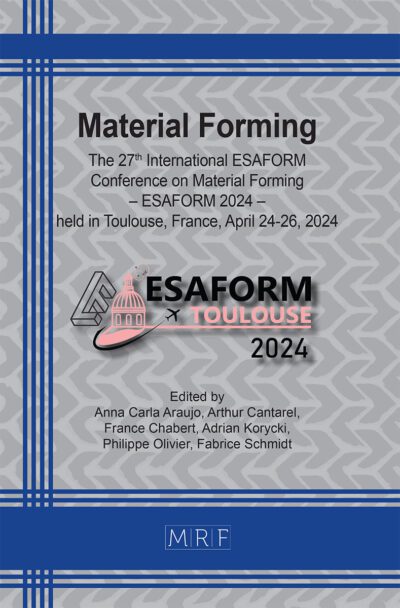Expert-informed neural network (EINN) for the forming depth prediction from a small-scale sheet metal forming database
Luca Quagliato, Mattia Perin, Vahid Modanloo, Taeyong Lee
Abstract. It is well established that supervised machine learning (SML) models often perform poorly when presented with new inputs outside their latent space, due to misalignment with the features learned during the training process. Although Physics-Informed Neural Networks (PINNs) have demonstrated promising results, their reliance on physics-based partial differential equations (PDEs) limits their applicability in manufacturing engineering, where PDEs are not easily definable. To overcome this challenge, this work introduces an Expert-Informed Neural Network (EINN), where PDEs are numerically derived based on engineering expertise and incorporated into the backpropagation scheme to enhance extrapolation accuracy. To evaluate the EINN architecture, a dataset comprising 15 finite element analyses (FEA) and 9 cold-warm stamping experiments on 0.1 mm thick pure titanium (Ti) sheets was employed. The EINN was benchmarked against two SML models, Extreme Gradient Boosting (XGB) and Deep Neural Networks (DNN) demonstrating similar training and validation scores with both benchmark models while outperforming them in predicting the forming depth limit in more complex scenarios beyond its original latent space, achieving an average accuracy improvement of over 25%.
Keywords
Sheet Metal Forming, Process Modeling, Expert-Informed Neural Network (EINN), Deep Neural Network (DNN), Extreme Gradient Boosting (XGB)
Published online 5/7/2025, 10 pages
Copyright © 2025 by the author(s)
Published under license by Materials Research Forum LLC., Millersville PA, USA
Citation: Luca Quagliato, Mattia Perin, Vahid Modanloo, Taeyong Lee, Expert-informed neural network (EINN) for the forming depth prediction from a small-scale sheet metal forming database, Materials Research Proceedings, Vol. 54, pp 1490-1499, 2025
DOI: https://doi.org/10.21741/9781644903599-161
The article was published as article 161 of the book Material Forming
![]() Content from this work may be used under the terms of the Creative Commons Attribution 3.0 license. Any further distribution of this work must maintain attribution to the author(s) and the title of the work, journal citation and DOI.
Content from this work may be used under the terms of the Creative Commons Attribution 3.0 license. Any further distribution of this work must maintain attribution to the author(s) and the title of the work, journal citation and DOI.
References
[1] J.P.T. Mo, S.C.P. Cheung, R. Das, Demystifying Numerical Models: Step-by-Step Modeling of Engineering Systems, first ed., Butterworth-Heinemann, 2019. https://doi.org/10.1016/C2015-0-05428-4
[2] M. Schwenzer, M. Ay, T. Bergs, D. Abel, Review on model predictive control: an engineering perspective, Int. J. Adv. Manuf. Technol. 117 (2021) 1327–49. https://doi.org/10.1007/s00170-021-07682-3
[3] O. Mypati, A. Mukherjee, D. Mishra, S.K. Pal, P.P. Chakrabarti, A. Pal, A critical review on applications of artificial intelligence in manufacturing, Artif. Intell. Rev. 56 (2023) 661–768. https://doi.org/10.1007/s10462-023-10535-y
[4] J. Cao, M. Bambach, M. Merklein, M. Mozaffar, T. Xue, Artificial intelligence in metal forming, CIRP Ann. (2024) 1–27. https://doi.org/10.1016/j.cirp.2024.04.102
[5] I. Mirandola, G.A. Berti, R. Caracciolo, S. Lee, N. Kim, L. Quagliato, Machine learning-based models for the estimation of the energy consumption in metal forming processes, Metals 11 (2021). https://doi.org/10.3390/met11050833
[6] S. Lee, J. Park, N. Kim, T. Lee, L. Quagliato, Extreme gradient boosting-inspired process optimization algorithm for manufacturing engineering applications, Mater. Des. 226 (2023) 111625. https://doi.org/10.1016/j.matdes.2023.111625
[7] S.M. Najm, I. Paniti, Investigation and machine learning-based prediction of parametric effects of single point incremental forming on pillow effect and wall profile of AlMn1Mg1 aluminum alloy sheets, J. Intell. Manuf. 34 (2023) 331–67. https://doi.org/10.1007/s10845-022-02026-8
[8] F. Mumali, Artificial neural network-based decision support systems in manufacturing processes: A systematic literature review, Comput. Ind. Eng. 165 (2022) 107964. https://doi.org/10.1016/j.cie.2022.107964
[9] S. Duan, D. Kozjek, E. Mehr, M. Anders, J. Cao, Forming force prediction in double-sided incremental forming via GNN-based transfer learning, J. Manuf. Process. 120 (2024) 867–77. https://doi.org/10.1016/j.jmapro.2024.04.093
[10] H.R. Attar, H. Zhou, A. Foster, N. Li, Rapid feasibility assessment of components to be formed through hot stamping: A deep learning approach, J. Manuf. Process. 68 (2021) 1650–71. https://doi.org/10.1016/j.jmapro.2021.06.011
[11] S.K. Dewangan, R. Jain, S. Bhattacharjee, S. Jain, M. Paswan, S. Samal, et al., Enhancing flow stress predictions in CoCrFeNiV high entropy alloy with conventional and machine learning techniques, J. Mater. Res. Technol. 30 (2024) 2377–87. https://doi.org/10.1016/j.jmrt.2024.03.164
[12] S. Feng, H. Zhou, H. Dong, Using deep neural network with small dataset to predict material defects, Mater. Des. 162 (2019) 300–10. https://doi.org/10.1016/j.matdes.2018.11.060
[13] Y. Wang, R.D. King, Extrapolation is Not the Same as Interpolation, Lecture Notes in Comp. Sci. 14276 (2023) 277–93. https://doi.org/10.1007/978-3-031-45275-8_19
[14] M. Raissi, P. Perdikaris, G.E. Karniadakis, Physics Informed Deep Learning (Part II): Data-driven Discovery of Nonlinear Partial Differential Equations, (2017) 1–22. https://doi.org/10.48550/arXiv.1711.10566
[15] J. Yu, L. Lu, X. Meng, G.E. Karniadakis, Gradient-enhanced physics-informed neural networks for forward and inverse PDE problems, Comput. Methods Appl. Mech. Eng. 393 (2022). https://doi.org/10.1016/j.cma.2022.114823
[16] S. Cai, Z. Mao, Z. Wang, M. Yin, G.E. Karniadakis, Physics-informed neural networks (PINNs) for fluid mechanics: a review, Acta Mech. Sin. 37 (2022) 1727–38. https://doi.org/10.1007/s10409-021-01148-1
[17] T. Chatterjee, M.I. Friswell, S. Adhikari, H.H. Khodaparast, Gradient Enhanced Physics-informed Neural Networks for Digital Twins of Structural Vibrations, Proc. of the 32nd Europ. Safety and Rel. Conf. (2023) 2586–93.
[18] V. Modanloo, H. Talebi-Ghadikolaee, V. Alimirzaloo, M. Elyasi, Fracture prediction in the stamping of titanium bipolar plate for PEM fuel cells, Int. J. Hyd. En. 46 (2021) 5729–39. https://doi.org/10.1016/j.ijhydene.2020.11.088
[19] S. Lee, Y. Lim, L. Galdos, T. Lee, L. Quagliato, Gaussian process regression-driven deep drawing blank design method, Int. J. Mech. Sci. 265 (2024) 108898. https://doi.org/10.1016/j.ijmecsci.2023.108898
[20] J. Ma, H. Yang, H. Li, D. Wang, G.J. Li, Tribological behaviors between commercial pure titanium sheet and tools in warm forming, Trans. Nonferrous Met. Soc. China 25 (2015) 2924–31. https://doi.org/10.1016/S1003-6326(15)63918-8
[21] W. Więckowski, J. Adamus, M. Dyner, M. Motyka, Tribological aspects of sheet titanium forming, Materials 16 (2023). https://doi.org/10.3390/ma16062224
[22] Modanloo V, Alimirzaloo V, Elyasi M, Optimal Design of Stamping Process for Fabrication of Titanium Bipolar Plates Using the Integration of Finite Element and Response Surface Methods, Arab J. Sc. Eng. 45 (2020) 1097–1107. https://doi.org/10.1007/s13369-019-04232-8












